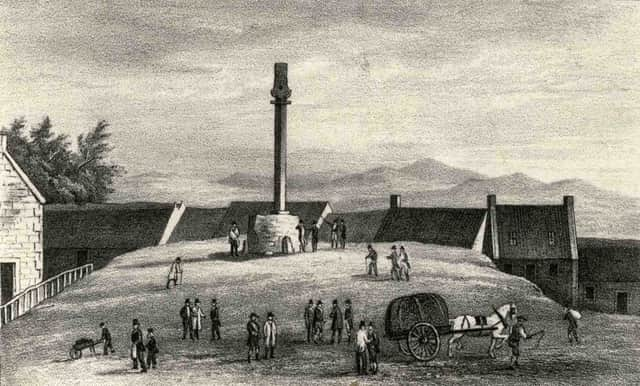Window on The Pastwith Ron Harris


In fact, if our great-great grandparents were to visit us from the past, they’d be stunned at how many of the landmarks of their day had now completely disappeared!
In Biggar, for example, its handsome High Street has undergone many changes of scenery in the past two centuries.
Advertisement
Hide AdAdvertisement
Hide AdUp until the early part of the 19th century, the main landmark in the town centre was The Knowe (pictured), a probably man-made mound topped by a large stone cross which stood near where the Corn Exchange is today. (A fragment from that old rugged cross is understood to be incorporated into a side wall of the Exchange.)
It was reputedly here where the original Hogmanay Biggar Bonfire was held along with a ceremony during which the town drummer made the proclamation that still serves as the town’s unofficial motto: “London’s Big, but Biggar’s Biggar!”
The Knowe was eventualy cleared and for some years another landmark which is now also long-gone took its place, the once huge and impressive Jubilee Fountain, a tribute to Queen Victoria’s lengthy reign.
Now the site of a less attractive but more functional car park, the grand fountain went during the new 20th century along with another change, that of the very name of the street in which it stood.
Advertisement
Hide AdAdvertisement
Hide AdOld Gazettes reveal that there was uproar in the town when it was decided that the traditional Main Street name be dropped in favour of the more prestigeous title of High Street.
The Biggar traders in particular were up in arms, protesting at the costs of changing all their stationery, street signs and commercial address listings.
Biggar wasn’t the only community around here which relatively quickly got rid of its tribute to old Queen Victoria.
Lanark paid homage to Her Majesty with a statue of Her the Cross with the half-century older statue of William Wallace glaring down at Her from his niche in Lanark Steeple.
Advertisement
Hide AdAdvertisement
Hide AdThe English-born queen’s image was eventually removed from the apparently dissapproving sight of the Scottish freedom-fighter when it became a hinderance to Lanark’s growing traffic flow. It’s removal also allowed the Lanimer Queen’s crowning ceremiony to move to its present location from near the Tolbooth on the High Street.
Some staunch Lanarkians even claim that the statue wasn’t shifted because of traffic at all but to show that, in the Royal Burgh at least, the Lanimer Queen took precedence over the British Queen!
There are about as many different legends about what eventually happened to old Queen Victoria’s statue as there are Lanarkians; some say it was moved to a less prominent position in the North Vennel before being broken up, now forming a rockery in a certain prominent Lanarkian’s garden!
Of course Lanark has seen many more former landmarks that the statue vanish over the years; Lanarkians in the fifties will still recall the stark St Leonard’s Church in Bannatyne Street before it was demolished to make way for the even starker Argyle House `buroo’ office.
Advertisement
Hide AdAdvertisement
Hide AdJust across the road, few mourned when the down-at-heel Caledonian Hotel, aka `The Trust’, was pulled down before it fell down in the late Nineties; even fewer realised at the time that this building was a very historic old Lanark coaching inn, dating back to the 1820’s.
A more recent casualty was the great Edwardian Lanark Grammar School in Albany Drive, once the town’s largest public building, cleared a few years ago for as-yet unbuilt new housing,
Carnwath’s centuries-old tolbooth and town jail survived many centuries near where the Town Hall now stands before being demolished; it survived long enough for photographs to exist of it. And, as for poor old Carluke, its historic `casualties’ during the cruel 20th century is going to need another article altogether to detail...